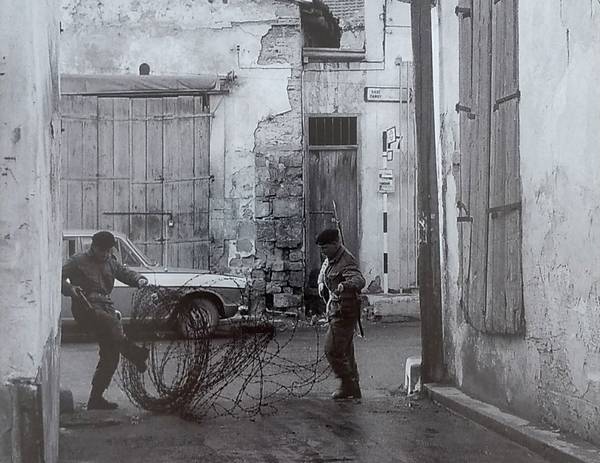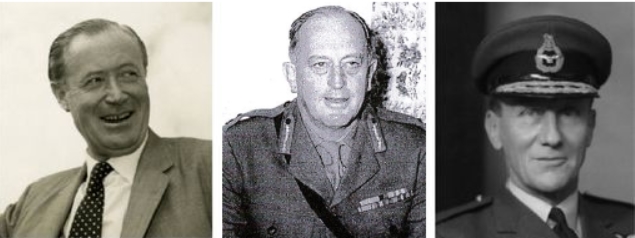A Green Line is Drawn
Due to the gravity of the situation the British Secretary of State for Commonwealth Relations, Duncan Sandys, flew to Cyprus on the 28th December arriving in Nicosia Airport at 05:50hrs.
After lengthy discussions with Major General Young and the local military & political leaders, Sandys set up a Political Liaison Committee (PLC) to arrange, amongst other things, the establishment of a ceasefire line between the two communities. The first meeting was held at the British High Commission on the morning of the 29th December.......the Alpha Net log records that the Commanders of the Greek & Turkish National Contingents were told to go to the High Commission at 09:20hrs.
Duncan Sandys, Major General Peter Young (Commander Land Forces) and Air Chief Marshal Sir Denis Barnett (Commander in Chief Near East Air Force and Commander British Forces Cyprus) were senior members of the Committee
Other participants were the British High Commissioner, the Ambassadors of Greece and Turkey, delegations from both Greek and Turkish Cypriots, the Commanding Officers of the Greek and Turkish National Contingents and Colonel John Sale, Defence Advisor at the British High Commission
Major General Young's staff (including his Intelligence Officer and ADC) waited next door at the Tac HQ - the passport office.
At 17:00hrs on Sunday 29th December the Political Liaison Committee met again for a momentous and lengthy meeting.
Major Perrett-Young (General Young's Intelligence Officer) recalls...........
"I believe it was during the Conference break that, at his (General Young's) request, I produced chinagraphs for him from the variety of colours I had brought up from Episkopi in my map case. The 'green' was no random selection. Bearing in mind factional sensitivities, my choice was quite deliberate. Blue and red, apart from the latter's association with the 'enemy', and with their Greek and Turkish connotations respectively, were hardly suitable. 'Green' usually used for marking emplacements/fortifications and minefields, seemed the least controversial".
Major-General Peter Young (Truce Force Commander) recalls........
"The Turks and sometimes Duncan Sandys pressed me to take on more and more. I sat there murmuring pigeon-like to myself, 'Think two down, Peter' and drew company and platoon goose eggs (tactical map-marking symbols for a defended locality) on my map and resisted when I saw that I was being asked to do more than I could militarily manage".
The above sequence of events is repeated by the future UN Chief of Staff, Brigadier Michael Harbottle in his book...........'The Impartial Soldier'.
"The meeting continued throughout the night with only one pause to allow the representatives to consult with their colleagues. Time and time again his (General Young's) green chinagraph pencil retraced the line across the talc of his field map, only to be rubbed out and changed in direction to suit the requirements of one side or the other. At last, the pencil wavered no more - and the Green Line was finally and irrevocably drawn".
The meeting finished at 05:00hrs (Monday 30th December 1963) having had a 90 minute break at 01:00hrs - Duncan Sandys had made it clear there would be no rest until an agreement was signed.
This is the final signed agreement (click the image to view the full version.....in a new window)
Note: The 'talc' referred to by Brigadier Harbottle was a flimsy type of Perspex which could be used as an overlay sheet. However, talc was the least accurate of the overlays as the map could move around under it if you weren’t very careful and its use cannot be confirmed.
Major Perrett-Young and Captain Christopher Meynell state that General Young did the drawing and amendments himself at the High Commission meeting with (they imagine) the interested parties 'leaning over his shoulder'.

A section of the map (with explanatory annotations) showing the agreed path of the Green Line which stretched beyond the limits of the walled city both to the west and to the east
Click the image or this link for the full version (opens in a new window)
Major-General Young then handed the 'Green Line' map and a copy of the typed agreement to Major Perrett-Young who was waiting next door in the TacHQ. The General's instructions were..........."get on with it".
Intelligence Corp NCOs then produced sufficient copies of the map and agreement to go out to the High Commission and Truce Force units.
Once the map reached unit level it would then have been further copied for use by patrol commanders - and others.
It is important to repeat that, contrary to other published descriptions, the original Green Line map was drawn by General Young only.

The author at the excellent Army Intelligence Corp museum with a 'Green Line' map
This may be the final version drawn by General Young or one of the first copies to be created by the Intelligence Corps for distribution to Units
Not often included in a description of this period was the hugely important role played by Colonel John Sale, the Defence Advisor at the British High Commission. He set up and ran their Operations Room and maintained the Alpha log. He spent a lot of time working with General Young and generally liaised between all parties. As the military man on the spot, he was the only person who knew all the Turkish, Greek and Cypriot players, plus the various Ambassadors and other military attachés. General Young, as a commander in the Bases, had a much more limited vision since the Bases in the 1960s had little contact with politicians and others in Nicosia.

Colonel John Sale giving one of his many briefings

The ceasefire line (the Green Line) was, in the main, not a physical barrier but in certain flash points in central Nicosia short sections of the Clemens Line were restored
Image courtesy of the Pachyammos Village Museum
A video summarising the events of December 1963

